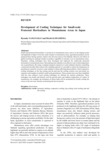Small-scale protected horticulture is carried out in mountainous areas, such as in the sloping terrain and highlands of Japan. Given the cooler climate in mountainous areas, agricultural products can be produced there during summer, which is the off-crop season in the flatlands. However, the effects of global warming are making it harder to produce vegetables in summer, even in mountainous areas. Therefore, cooling techniques have been developed and improved for small-scale protected horticulture in mountainous areas. Intercepting solar radiation is an effective way to limit temperature rise in greenhouses. By using a computer program responsive to solar radiation intensity controlling a motorized movable shaft system with a shading material, it is possible to reduce the temperature in greenhouses caused by excessive-solar radiation without affecting photosynthesis. Such evaporative cooling techniques as the fog cooling and the pad and fan cooling systems were previously too expensive and complex to install in small-scale greenhouses. These systems have now been simplified with the costs reduced. Local cooling techniques are efficient for summer production. These techniques can locally and directly cool the specific parts and ambient temperature of a plant. In strawberries, for example, the formation of flower buds will be accelerated by locally cooling the crown or the root zone, thereby accelerating the harvest period.

